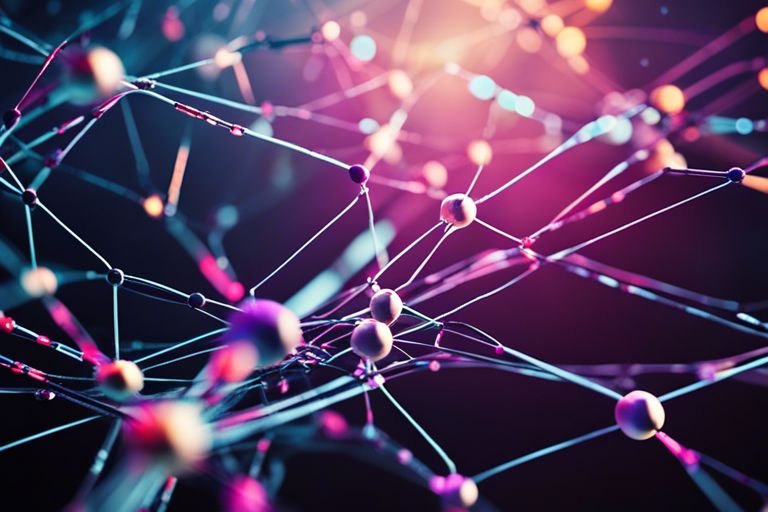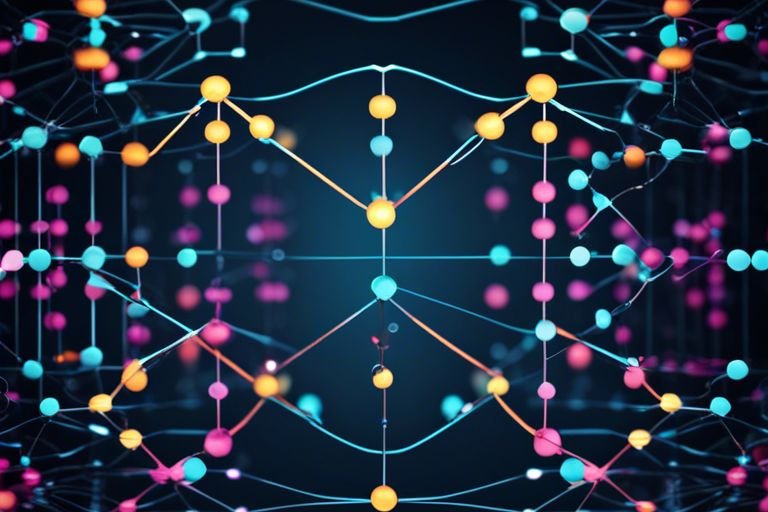You’ve heard about neural networks and how they are revolutionizing the field of artificial intelligence. Neural networks are at the core of deep learning, enabling machines to learn from data and make decisions in a way that mimics the human brain. This guide is designed for beginners who want to look into the exciting world of neural networks. By the end of this post, you will have a clear understanding of what neural networks are, how they work, and the basic terminology associated with them. Let’s unravel the mysteries behind this powerful technology together.

Key Takeaways:
- Neural Networks: Neural networks are a set of algorithms modeled after the human brain that are designed to recognize patterns.
- Layers of Neurons: Neural networks are made up of layers of neurons that process data and information to make predictions or classifications.
- Activation Functions: Activation functions introduce non-linear properties to the neural network, allowing it to learn complex patterns in the data.
- Backpropagation: Backpropagation is an algorithm used to update the weights of the neural network to minimize the error between predicted output and actual output.
- Training and Testing: Neural networks require training on labeled data to learn patterns and then are tested on unseen data to evaluate their performance and generalization abilities.

The Anatomy of a Neural Network
Neural networks are the building blocks of modern artificial intelligence. To understand how they work, it’s necessary to break down the components that make up a neural network. From neurons to layers, each element plays a crucial role in processing information and making predictions.
1. Explain the structure of a neuron in a neural network.
2. Describe the different types of layers in a neural network.
3. Discuss the importance of activation functions in deep learning.
4. Explore the concept of backpropagation in neural networks.
5. Explain the role of weights and biases in a neural network.
Neurons and Layers: The Building Blocks
While neural networks may sound complex, at their core, they are made up of simple components called neurons. Neurons are mathematical functions that take inputs, apply weights and biases, and pass the output through an activation function to the next layer. These neurons are organized into layers, each serving a specific purpose in processing data.
1. Describe the function of a neuron in a neural network.
2. Explain the concept of input, weights, biases, and output in a neuron.
3. Discuss the different types of layers in a neural network and their functions.
4. Explore the process of forward propagation in a neural network.
5. Explain the significance of the activation function in determining the output of a neuron.
Understanding Weight, Bias, and Activation Functions
You might wonder what role weights, biases, and activation functions play in a neural network. These elements are necessary for the network to learn from data and make accurate predictions. Weights represent the strength of connections between neurons, biases allow neurons to adjust the output along with the activation function, which introduces non-linearity and complexity to the model.
1. Explain the importance of weights and biases in a neural network.
2. Describe the function of activation functions in a neural network.
3. Discuss the types of activation functions commonly used in deep learning.
4. Explore the role of backpropagation in adjusting weights and biases.
5. Explain how a neural network optimizes its parameters during training.
Building a neural network requires a deep understanding of its components. Weights and biases determine how information flows through the network, while activation functions introduce non-linearity, allowing the model to capture complex patterns. It’s necessary to grasp these concepts to design efficient and accurate neural networks that can tackle a variety of tasks.
How to Build Your First Neural Network
Once again, you’ve decided to examine into the world of neural networks. Building your first neural network can be an exciting yet daunting task. To guide you through this process, we will break it down into manageable steps. From choosing the right tools and software to designing and implementing your basic neural network, we’ve got you covered. Let’s get started!
1. How to install TensorFlow for beginners
2. Step-by-step guide to building a neural network from scratch
3. Introduction to neural network architecture
4. Tips for training your first neural network
5. Common pitfalls to avoid when building neural networks
Choosing the Right Tools and Software
Tools and software play a crucial role in building neural networks. As a beginner, it’s imperative to select the right tools that align with your learning goals and level of expertise. Popular tools like TensorFlow, Keras, and PyTorch provide user-friendly interfaces for creating neural networks. Additionally, utilizing platforms like Google Colab can help you leverage the power of GPU computing without the need for expensive hardware.
1. Best software for beginner neural network projects
2. GPU vs. CPU for neural network development
3. Setting up a development environment for neural networks
4. Choosing the right programming language for neural network projects
5. Understanding the role of libraries in neural network development
Steps to Design and Implement a Basic Neural Network
The process of designing and implementing a basic neural network involves several key steps. From defining your problem statement and dataset to selecting the appropriate network architecture and training your model, each step is crucial to the success of your neural network project. By following a structured approach and leveraging the right tools and techniques, you can build a solid foundation in neural network development.
1. Data preprocessing techniques for neural networks
2. Choosing the right activation function for your neural network
3. Hyperparameter tuning for optimizing neural network performance
4. Implementing common neural network architectures (e.g., CNN, RNN)
5. Troubleshooting techniques for debugging neural network errors
The process of designing and implementing a basic neural network is multifaceted, requiring attention to detail and a solid understanding of fundamental concepts. From preprocessing your data to fine-tuning hyperparameters, each step plays a critical role in the overall performance of your model. By following a systematic approach and continuously refining your techniques, you can gain valuable insights into the vast potential of neural networks in various applications.
1. How to choose the right activation function for your neural network
2. Common pitfalls to avoid when designing neural network architectures
3. Benefits of using transfer learning in neural network projects
4. Understanding the impact of dropout regularization on neural network performance
5. Interpreting the results of your neural network model effectively
To build a successful neural network, you must carefully select your tools and software, follow a structured approach in designing and implementing your model, and pay close attention to crucial details throughout the process. By taking these steps seriously, you can avoid common pitfalls, optimize your model’s performance, and unlock the full potential of neural networks in your projects.

Training Neural Networks
Unlike conventional programming, where explicit instructions are provided, neural networks learn from data. This process, known as training, involves adjusting the network’s parameters to minimize the difference between the predicted output and the actual target. Training a neural network requires not only a good understanding of the network architecture but also an optimized approach to data preparation and training parameters.
1. Train a neural network to classify images.
2. Fine-tune a pre-trained neural network for a specific task.
3. Implement deep neural networks for natural language processing.
4. Train a neural network using reinforcement learning.
5. Optimize hyperparameters for neural network training.Data Preparation and Importance of Quality Data
Neural networks are heavily dependent on the quality of the data they are trained on. Garbage in, garbage out, a common saying in the field, emphasizes the significance of clean, relevant, and well-prepared data for training neural networks effectively. Before feeding data into a network, it’s crucial to preprocess, clean, and normalize the data to ensure the best training outcomes.
1. Prepare a dataset for training a convolutional neural network.
2. Explain the importance of data augmentation in neural network training.
3. Clean and preprocess text data for training a recurrent neural network.
4. Normalize numerical data for training a neural network.
5. Handle missing values in a dataset before training a neural network.Tips for Efficient Training: Learning Rate and Backpropagation
Neural networks incorporate complex algorithms like backpropagation to update weights and biases during training, and choosing an appropriate learning rate is crucial for convergence. Setting a suitable learning rate and understanding how backpropagation works can significantly impact the training speed and the ultimate performance of the neural network.
1. Determine the optimal learning rate for training a neural network.
2. Explain the role of momentum in backpropagation for faster convergence.
3. Implement adaptive learning rate techniques like Adam optimizer for efficient training.
4. Troubleshoot gradient vanishing or exploding during neural network training.
5. Regularize neural networks using techniques like dropout for better generalization.Data preparation is a crucial step in neural network training as it directly impacts the model’s performance. Ensuring clean, relevant, and well-structured data enhances the network’s ability to learn patterns effectively. Thou, investing time and effort in data preprocessing and quality assurance pays off in the long run.
Evaluating and Tuning Neural Networks
After training a neural network, the next crucial step is evaluating and tuning its performance to ensure optimal results. Fine-tuning involves adjusting various parameters and architectures to enhance the model’s accuracy and generalization. Below are some key aspects to consider when evaluating and tuning neural networks:
1. Generate predictions on unseen data
2. Calculate various performance metrics like accuracy, precision, and recall
3. Visualize learning curves to spot overfitting or underfitting
4. Implement regularization techniques like dropout or L1/L2 regularization
5. Experiment with different optimizers and learning rates
6. Hyperparameter tuning using techniques like grid search or random search
7. Conduct sensitivity analysis to determine feature importance
8. Consider ensemble methods for improved performance
How-to Analyze Neural Network Performance
Even before deploying a neural network model, it’s crucial to carefully analyze its performance to ensure it meets the desired criteria. Evaluating a network involves examining various metrics such as accuracy, loss, precision, recall, and F1 score. By comparing these metrics on training and validation datasets, one can identify potential issues like overfitting or underfitting and make necessary adjustments to enhance the model’s performance.
- Generate predictions on test data and calculate metrics
- Plot confusion matrices to visualize model performance
- Analyze ROC curves for binary classification models
- Evaluate calibration curves for probability predictions
- Use cross-validation to assess model stability and reliability
Factors Affecting Network Accuracy and Tips for Improvement
Any neural network’s accuracy is influenced by various factors, including the quality and quantity of training data, network architecture complexity, hyperparameter settings, and regularization techniques. To improve accuracy, one must carefully consider these factors and make informed decisions to fine-tune the model for optimal performance. Assume that:
- Data quality and quantity: Insufficient or noisy data can lead to poor generalization. Collecting more diverse and relevant data can enhance model accuracy and robustness.
- Hyperparameters and architecture: Tuning hyperparameters like learning rate, batch size, and network depth can significantly impact model performance. Optimal configuration is crucial for accuracy improvement.
- Regularization techniques: Implementing methods like dropout, batch normalization, or weight regularization can prevent overfitting and improve generalization of the network.
- Training duration and resources: Longer training times and access to powerful hardware can lead to better convergence and ultimately higher accuracy. Proper allocation of resources is crucial for model training.
Affecting neural network accuracy requires a multi-faceted approach that involves fine-tuning various aspects of the model. By carefully considering factors like data quality, hyperparameters, and regularization techniques, one can significantly enhance the accuracy and robustness of neural networks for diverse applications.
Practical Applications and Examples
Many industries and sectors have begun to harness the power of neural networks for various applications. Here are some chatGPT prompt samples related to this subsection:
- How are neural networks used in healthcare?
- What are some examples of neural networks in finance?
- Can you provide insights into the use of neural networks in autonomous vehicles?
- Explain the role of neural networks in natural language processing.
How Neural Networks Are Used in Industry
Networks in industries like healthcare, finance, autonomous vehicles, and natural language processing have significantly enhanced performance and efficiency. Here are some chatGPT prompt samples related to this subsection:
- How do neural networks contribute to advancements in medical diagnosis?
- What role do neural networks play in algorithmic trading?
- Explain how neural networks improve the accuracy of self-driving cars.
- Can neural networks help in sentiment analysis and language translation?
Simple Projects to Explore Neural Networks
While exploring neural networks, beginners can engage in simple projects like image recognition, stock price prediction, text generation, and game development. Here are some chatGPT prompt samples related to this subsection:
- How can I create a basic image recognition model using neural networks?
- What steps are involved in building a stock price prediction model with neural networks?
- Can you provide guidance on generating text using neural networks?
- What are some beginner-friendly game development projects involving neural networks?
More on Simple Projects to Explore Neural Networks
With the rise of online tutorials and user-friendly tools, beginners can easily look into neural network projects. It’s important to start with basic concepts and gradually move to more complex tasks. Here are some chatGPT prompt samples related to this subsection:
- What are the best resources for beginners to learn about neural networks?
- Can you outline a step-by-step guide for creating a neural network model?
- What are some common challenges faced by beginners in neural network projects?
- How can beginners avoid overfitting issues in their neural network models?
With applications in healthcare leading to faster and more accurate diagnoses, finance benefiting from improved algorithmic trading strategies, and autonomous vehicles becoming safer and more efficient with neural network technology, the impact of neural networks in various industries is undeniable. By launching on simple projects such as image recognition or text generation, beginners can gain hands-on experience and deepen their understanding of neural networks.
To wrap up
With these considerations in mind, beginners can now understand the basics of neural networks. By grasping the core concepts of neurons, layers, weights, biases, and activation functions, one can appreciate how neural networks process information and make predictions. To investigate deeper into this fascinating topic, continue exploring resources such as What is a Neural Network? and experimenting with different neural network architectures. Neural networks are powerful tools with vast potential for applications in various fields, making them an exciting area for continuous learning and innovation.
FAQ
Q: What is a neural network?
A: A neural network is a set of algorithms modeled after the human brain that is designed to recognize patterns. It learns from labeled data and is capable of extracting features and detecting relationships in the data.
Q: How does a neural network work?
A: A neural network consists of layers of interconnected nodes (neurons) that process and transmit information. The input layer receives data, the hidden layers process the information, and the output layer produces the result.
Q: What are the different types of neural networks?
A: There are several types of neural networks, including feedforward neural networks, convolutional neural networks (CNN), recurrent neural networks (RNN), and long short-term memory networks (LSTM).
Q: What is the training process for a neural network?
A: The training process for a neural network involves feeding it input data with known labels, adjusting the weights and biases of the network based on the error, and repeating this process until the network achieves the desired level of accuracy.
Q: What are some common applications of neural networks?
A: Neural networks are widely used in various fields, including image and speech recognition, natural language processing, autonomous vehicles, and financial forecasting. They are also used in healthcare for disease diagnosis and treatment planning.







